SolidWorks Releases COSMOSWorks 2008
SolidWorks provides a visualization toolkit for evaluating the performance and operational characteristics of your 3D design.
Latest News
January 13, 2008
By Al Dean
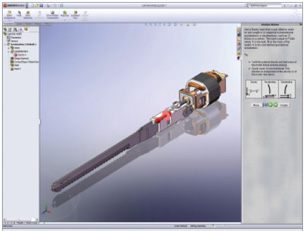 The Load/Restraint Advisor prompts the user for important model information before providingexpert suggestions on options. It’s a discrete dialog that solves a variety of common problems. |
Every SolidWorks release is a pretty big undertaking. After all, there’s a lot of software packed into each package. And while the new user interface, the new direct-interaction methodologies, and other bright shiny things from SolidWorks 2008 (See DE June 2007) have gained the big coverage, there’s plenty of meat to sink your teeth into elsewhere. I’m going to take a quick look at what those of us into simulation and analysis can find to make good use of.
As most SolidWorks users know but the rest of us might not, the SolidWorks Office Premium offering now includes a good deal of analysis technology in the form of COSMOSWorks Designer, so we’ll take a look at that, then briefly see what’s available in the other products.
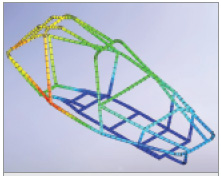 COSMOSWorks Designer can now analyzestructural members in chassis using moreefficient beam elements. |
Let’s start with Connectors. The design verification development team has been consistently developing this aspect of the program for the past few years, and has created a series of features to be used within the analysis process that automate a lot of the setup typically associated with definition of complex analysis situations.
The Bolt Connector is a perfect example. Rather than having to create a series of constraints that replicate the interaction between the bolt, fastener, and material with which it interacts, the Bolt Connectors allow you to define it in a single operation, automatically determining the head and nut diameter for holes that are created using the Hole Series wizard.
For the 2008 release, the Bolt Connector has been extended to allow you to connect more than two components (e.g., with a passthrough) and it now supports countersunk bolts. Alongside this, the automation aspects mean you can assign the bolt connector analysis feature to all “hole series” bolts in a single click. Also, on the subject of connectors, the Pin Connector has been worked to allow you to both include a pin weight and a mass value for that pin, so your model is more accurate when you’re performing frequency or buckling analyses.
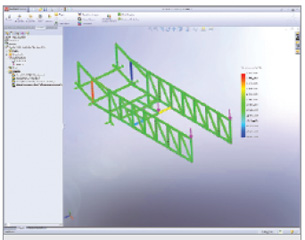 COSMOSWorks Designer allows users to plot the shear force and bendingdiagrams for all or selected structural members. |
Moving on, COSMOSWorks 2008’s ability to analyze structural members (framework, etc.) has been updated to both follow the updates to the modeling tools and to extend what can be achieved. Relating to mirroring modeling updates, the tools now allow you to directly support curved, mirrored, and patterned structural members. You can also now add loads and supports on faces in addition to joints and you can mix up your meshes to analyze both thick and thin parts with structural members. For those working with frameworks combined with sheet metal and other engineering components, this will be a major boost, as all types of components can be simulated in a single study. Finally, you can now generate Shear force and bending moment diagrams as part of the reporting process.
Moving away from updates to simulation technology, COSMOSWorks 2008 introduces a new learning tool, which is going to make it useful to both the new user and to the more experienced user looking for a refresher or to learn new tools. The Load/Restraint Advisor is one of those automated assistant tools that we all know and love, but thankfully, it’s not presented in the form of an anthropomorphic tetrahedral element, but rather as a discrete dialog that solves a variety of commonly encountered problems, such as whether to use support or load, what type of load to use, and what contact represents part interaction.
There’s also been work done in COSMOSWorks 2008 to assist with design optimization and gaining greater insight into the behavior of your products. Using a simple slider, you can have the system cut away your mesh to remove areas where loading reveals a concentration of material. ANSYS produced technology some time ago that actually removed elements from a design based on the same factors and while it was an interesting exploration tool, you would always have to remodel anyway, so this does much the same without that overhead. When you move that slider, you’ll gain an understanding of where material needs to remain and where material could potentially be removed. In these days of increasing material costs, this could be a really useful tool.
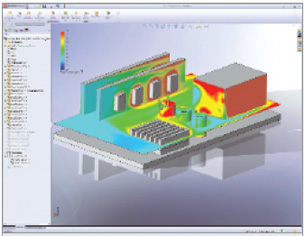 Fluid flow analysis is enabled by COSMOSFloWorks.With it, you can turn offa fan if the sensor temperature drops below a certain value. |
Extending capability
If you’re looking to extend your use of simulation a little further, then there are upgrades available. COSMOSWorks Professional builds on the Designer product and adds more design optimization, thermal heat transfer, vibration, buckling, fatigue analysis, and a wizard-driven drop test tool. The COSMOSWorks Advanced Professional module brings in nonlinear analysis, dynamic loading, and the behavior of composite materials. These have moved on apace with this release.
As to the highlights, for the 2008 release cycle, COSMOSWorks Professional includes trend analysis tools that allow you to evaluate the “impact of successive design changes on base design by allowing the users to focus on relative results instead of absolute.” Essentially, you can provide the system with a range of design changes to make, the system runs the analyses, and you can see how the variation in each run adds to the trend, so you can see where things are headed (for bad or good). Also, there are new tools to assist with stress linearization, according to the ASME pressure vessel code, combining multiple static study results to calculate stress due to dead load, live load, thermal load, seismic load, and whatnot.
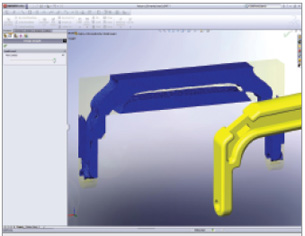 The Design Insight plot on an initial handle model is clearly suggesting thatthe I-beam cross-section and chamfered corners will yield an optimal design. |
Fluid Flow analysis
The SolidWorks 2008 release brought an interesting addition for SolidWorks users in COSMOSFloXpress. This follows the concept of COSMOSXpress where basic part analysis tools are given away for free, but applied to the fluid flow. Essentially, it’s based on Flomerics technology (which develops the full COSMOS FloWorks product) and is a wizard-driven process that lets you conduct a rudimentary fluid flow analysis of a part or assembly. Only a single inlet and outlet can be defined, the fluid can only be air or water, and you can only view velocity effects of the flow using dynamic sections and surface plots. But as a dip of the toe into the waters of fluid flow analysis, it’s a good start.
Of course, if you’re looking to do some real work, then COSMOSFloWorks is what you need. Updates for this release include revisions to the physical models available, including real gases, heat transfer in porous media, and using a perforated plate as an opening. Alongside the physics updates, there’s been work done on automatic lid creation, healing of geometry, and an extended engineering database that now includes fans (as used in electronics) and non-Newtonian fluids like blood, honey, pasta, etc. Finally, multicore processor support has been added and is available at no extra cost, unlike many other CFD codes.
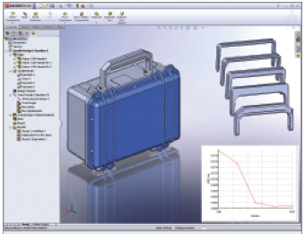 The stress, deflection, or other critical product performance indicators aretracked automatically in the Trend Tracker tool as designers exploremultiple iterations of their designs. |
The Obvious Choice
The 3D market is maturing and, personally speaking, I’m not convinced about the numbers of users still out there looking to move to 3D — particularly from my European point of view. The impression I have is that the vast majority of users have made their choice in 3D product development tools and are expanding in terms of adoption in the design office (to fully replace 2D processes). Whatever the truth, locally or globally speaking, facts are that many have adopted or begun to move to 3D-based design processes and are also looking to expand what they can do with that rich source of data. Simulation is the next logical step. If you’re designing your products in 3D, then it makes sense to use that same data and use it to test that product in terms of its behavior and function. Within the SolidWorks community, the obvious choice is of course, COSMOS Works.
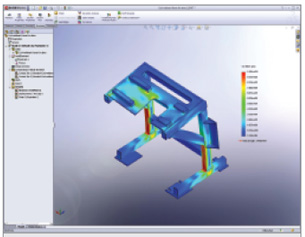 The bonded contact has been improved to give better results for modelswith different mesh densities between bonded faces, especially importantwhen using the h-adaptive method. |
This release includes capabilities expanded in both the tools available within the SolidWorks Office Premium and the add-in, more advanced modules to complete the system. For me, the Connectors concept is compelling; instead of redoing the same steps time after time, better to create a reusable formalized feature. I also love the Trend Analysis, Design Optimization tools — these, used correctly, can give you amazingly rich information to assist with ensuring your product can fulfill its requirements, but without over-engineering and without waste. And, in these days of concentration on sustainability and all things green, that’s an incredible toolkit to have in your arsenal.
COSMOSWorks looks good and provides you with a full suite of tools that mean you can not only define your product in 3D, but also evaluate its performance, operational characteristics, all within the same environment, making the most of connections between CAD, FEA, and CFD. In short, it’s damned cool.
More Info:
SolidWorks Corp.
Concord,MA
Al Dean is technology editor at MCAD Magazine, a UK product development and manufacturing technology journal and is editor of Prototype magazine. You can send comments about this article to [email protected].
Subscribe to our FREE magazine, FREE email newsletters or both!
Latest News
About the Author
DE’s editors contribute news and new product announcements to Digital Engineering.
Press releases may be sent to them via [email protected].






